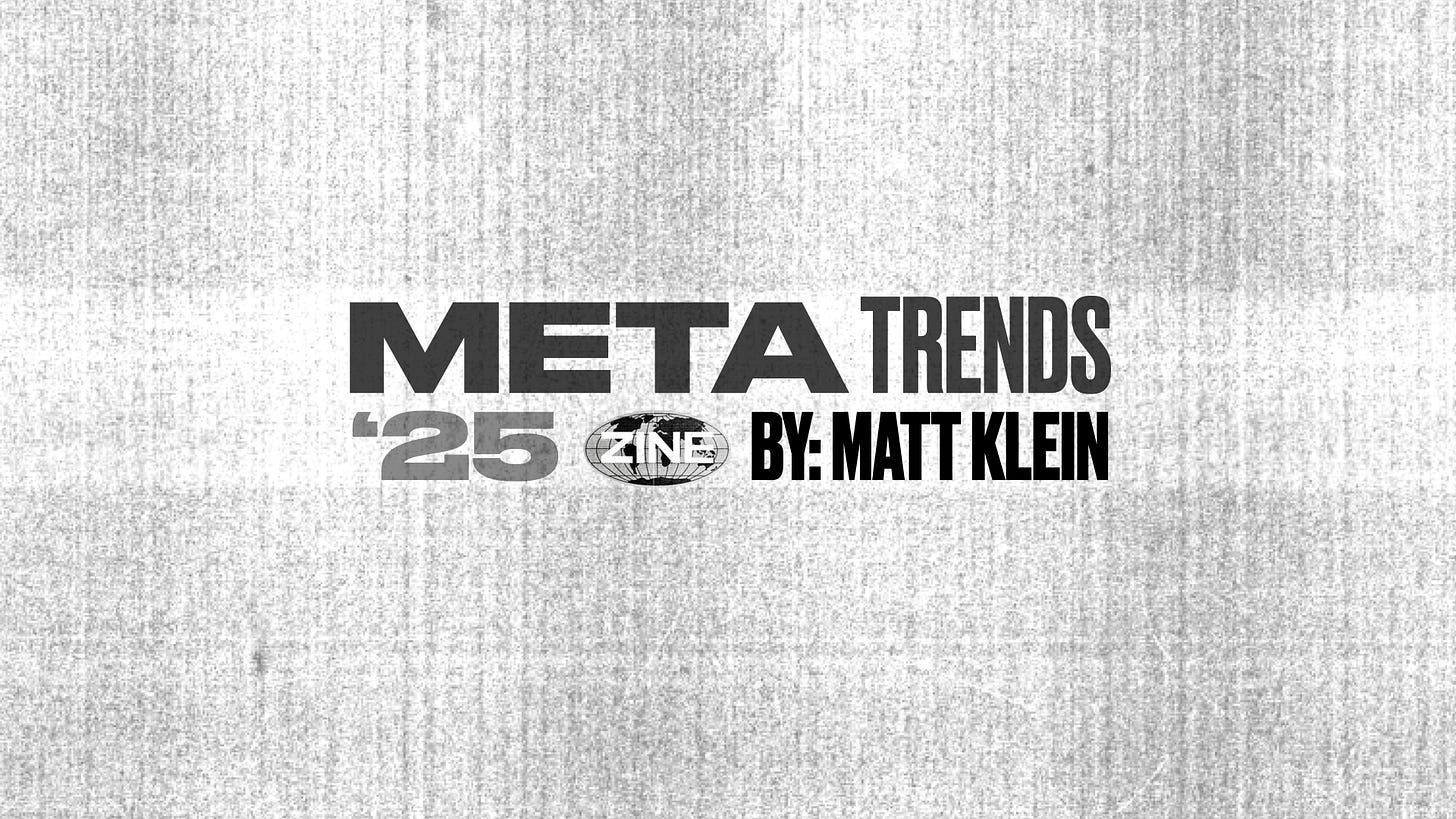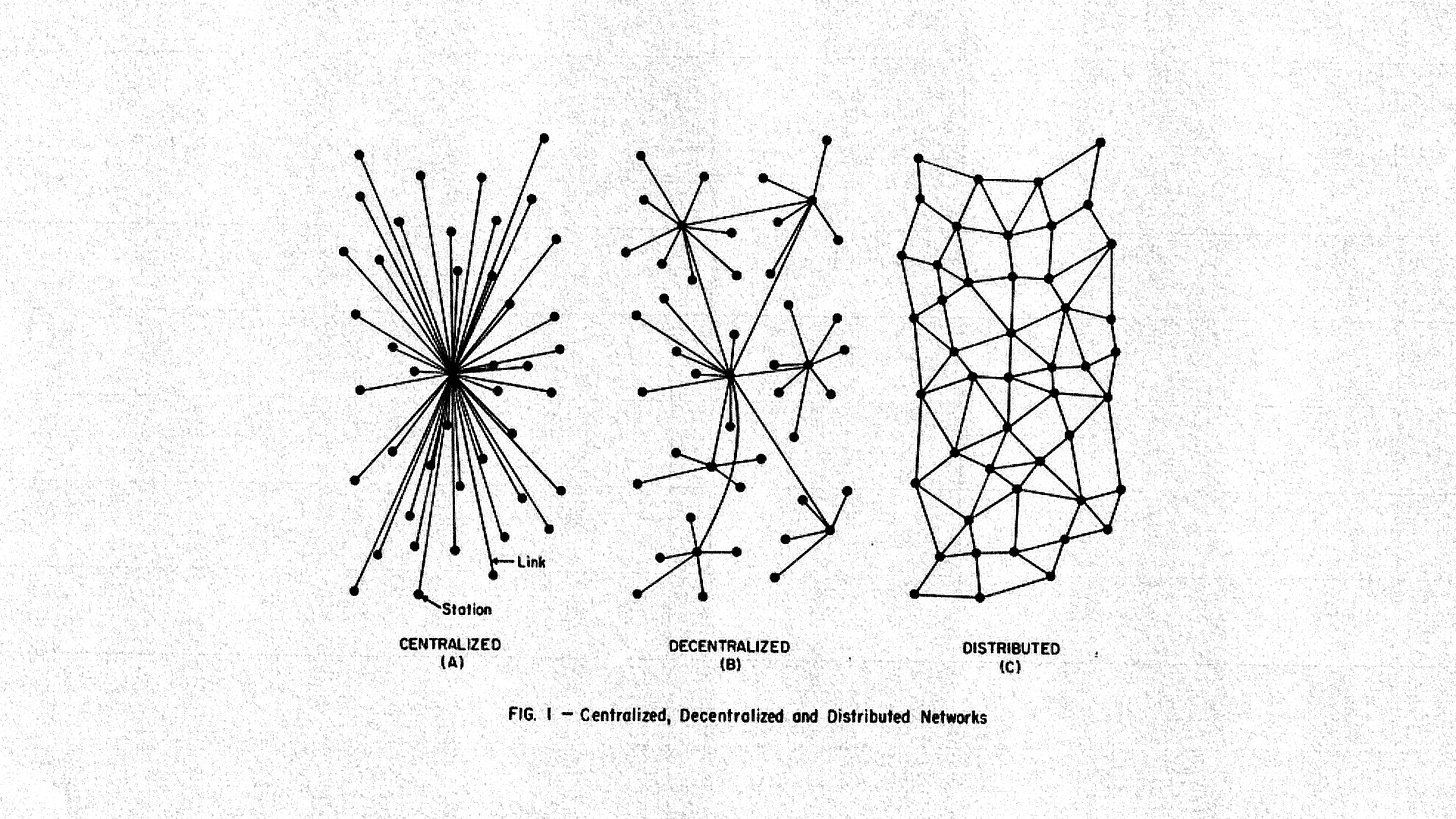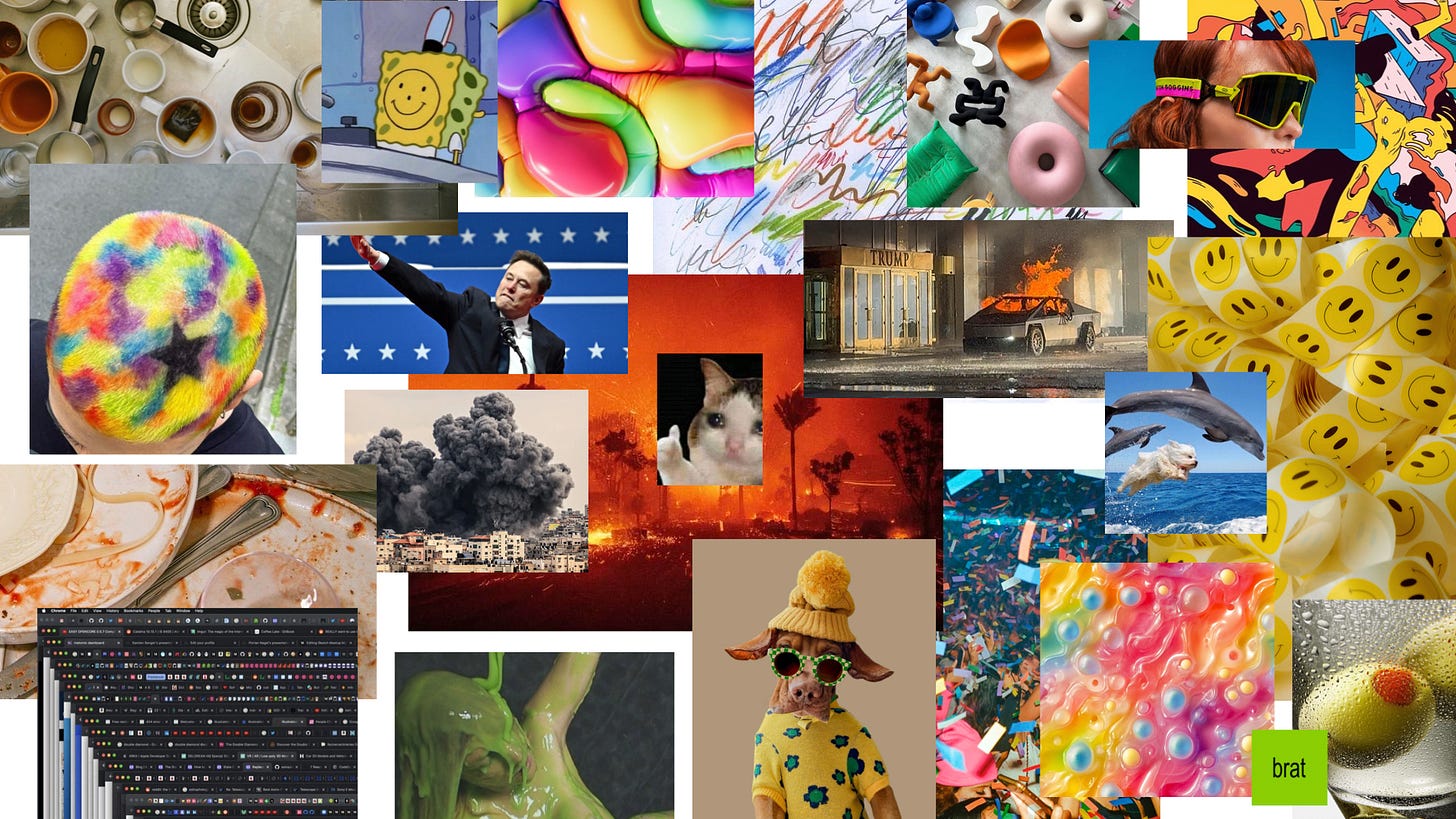The META Trending Trends: 02025
An Analysis of 70+ Global Trend Forecasts → 13 Most Reported Social Shifts
Trend Cosplay
02025’s Prologue
Life and business as we know it is only getting “weirder” — our change is seemingly more off-putting, nimble and dire “than ever before.” Maybe that’s always been the case. But if so, it shouldn’t trivialize the hurt and confusion we face.
Shit’s real weird, huh?
Trends, in their truest sense, are meant to decrease uncertainty and increase confidence in our awareness and decision making. The crystal ball is a damaging symbol to this practice. Rather, more accurately, foresight offers us a map, compass and thermometer to navigate a terrain and its climate more intelligently.
Foresight makes the alien feel less alien.
Unfortunately, the vast majority of our trend fodder today does not help us in our pursuit of judiciously navigating change. Instead it pumps hype and entertains us, dialing up the existing, deafening noise which we’re tasked with listening to.
As cultural researcher Victoria Buchanan points out, perhaps this is reflective of the much larger shift in the “junk-ification of our information.” This cheapening is likely what’s granting permission and opening the floodgates for even more published trend analysis.
There are now 250+ forecasts published annually.
Over the last 5 years, the number of published trend reports nearly doubled.
Trends are trending.
So much so, that that line is now trending.
For futurist Tracey Follows,
“...there are more trend reports than in any previous year and yet we seem to be less prepared than ever.”
Clearly, more isn’t better.
As I found, less than half of those published reports list a methodology — let alone a rigorous one. Unfortunately, nearly the same number of orgs share a methodology as inject ads for their services in between their pages.
The vast majority of trend reports are not forecasts — they’re corporate advertisements.
And these “advertisements” peacocking “we know change” aren’t even changing. Year after year, not only are orgs repeating one another, but they’re repeating themselves.
Last year I asked 200 strategists around the world if they could distinguish between trends published from 2018 or 2024. Turns out you were better off guessing 50-50 than actually trying to discern the difference. The experts can’t tell when something was published six years apart.
Another interesting signal... In announcing the upcoming release of this 2025 report, I linked to last year’s report, showcasing what was to come. But to my surprise — more people than you’d expect — began sharing last year’s report, thinking it was the new one. In other words: 2024’s report read as if it was hot off the presses.
My theory stands: 1. Maybe we’re impatient, thinking that trends have a 365 day shelf life, while, in reality, culture moves much slower than we expect or want it to. Moving at the "speed of culture” should not be a synonym for “fast.” And, 2. simultaneously, maybe these reports really are scratched, repeating, broken records.
To further test this theory of repetition, I partnered with Tim Stock and Marie Lena Tupot of scenarioDNA, a cultural research and advisory firm specializing in the use of computational linguistics to understand trends. We fed eight years worth of trend reports into their patented Culture Mapping tool — a semiotic and linguistic system to quantify and map phrases into one of four language quadrants: Residual, Dominant, Emergent or Disruptive.
From the analysis of literally thousands of pages of trend talk, we found that since 2018, the overwhelming majority of report language is tagged as either Dominant or Residual.
TL;DR: Trend reports, in aggregate, should not be seen as sources of emergent or disruptive thinking, but rather culprits of repackaging established nomenclature.
We’ll, how could this be happening?
For starters, strategist Amy Daroukakis found that 90% of trend reports come from only 10 cities in the world: London, New York, Tokyo, Paris, Shanghai, Los Angeles, Amsterdam, Berlin, São Paulo and Seoul.
This grim, uninspiring lack of global representation, in combination with a lack of rigorous let alone quantitative analysis or external collaboration + toxic positivity + fear of risk, reflection, and realism + industry peacocking + commercial bias, ultimately prevents trend reports from ever reaching their fullest potential value: judiciously navigating our change.
But does anyone really give a shit? Pop another In-Out list and ask AI about the future, a literal embodiment of the past and average.
Anyone in this profession worth their salt knows that there’s no such thing as “prediction.” Rather, foresight’s real value is opening doors to opportunity: not what will be, but what can be.
Trends are not answers, but chances to ask questions.
This work is upstream of such investment, influence, and innovation that there’s a shared responsibility to more mindfully approach this work. It’s too important not to —
A study by Codeword, a comms agency, found that 150 trend reports contributed to over +14B impressions globally.
Calling for more rigor here isn’t “gatekeeping,” but an invitation for more participation: questioning, debate and productive disagreement. We require: Futures Literacy & Cultural Fluency.
Why?
In understanding is empowerment.
And in empowerment is change.
These reports are self-fulfilling prophecies. Orgs report what already exists and we then create worlds inspired by whatever’s framed as “trending.” Copy-paste. But...
Are we mindful of what we’re feeding back into our systems?
As individuals and corporations, for the sake of our sanity and futures, we must continue fighting the oppressive nature of status-quo-ism and break out of this cycle of trend regurgitation.
3 Ways to Dismantle the Self-fulfilling Prophecies of our Trend Reports:
01. Talk to Others
The most frequent question I get asked is: “What and who do you follow?” We have an obsession with sources of input. (I do too.)
But input is only as good as the people we reflect upon matters with.
We need to get out of our own heads and into conversation with others. When I advise “fringes are the future and we must seek the overlooked,” that’s not just the underground, subversive and unknown, but — more simply — voices and markets not represented.
Seek global perspectives.
Invest in your network.
Question your own beliefs.
Whether you invest in dozens of global perspectives as a part of a project’s scope, or chat with one person outside of your profession, seek to augment your thinking.
Dialogue with others, and ‘the' others — those you oppose.
These perspectives strategically shatter herd-like group-think, which currently plagues this work.
Talk to others.
02. Seek Edges & Narratives
In network theory, diagrams visualize dots (“nodes”) and the lines which connect them (“edges”). Combined, they create maps: What’s connected to what?
In our work, these clusters of nodes are our “trends.” The more clusters of signals of change we collect, the more clear our view is.
But — we’re spending a whole lot of time chasing down and hoarding nodes, and not enough on the lines, which connect them.
For cultural anthropologist, Grant McCracken,
“Chunking change is as far as some people get [...] Bagging and tagging is not enough.
We want a concept of change, a theory of change, a search for the meaning and mechanics of change. Only thus can we get better at reading change.”
Lines are our narratives — stories of change.
A trend practice fails because one myopically focuses too much on the nodes, and not enough on the coalescing narratives which connect them all. These edges embody perspective, nuance and historical context. Over-simplification occurs when there are too few edges.
Coincidently, at the time of writing this, the world’s home for edges and storytelling is in embers.
For maker, marketer and mystic, Will Cady,
“The fires in Los Angeles were a mandate to our greatest cluster of storytellers. That mandate? At this time of profound collective change we must rewrite the stories, which humanity needs to be told right now.
The future just hit our metabolizers of great fears into great hopes.
Narratives carry an essential motivating factor that data lacks: the interiority of experience. Inside of any trend is an emotional dimension that drives the human element toward its futures.
It’s not enough to tell people what’s coming.
They have to feel it.”
Nodes have no meaning.
Meaning is in the emotional edges.
Seek the edges.
03. Pollinate & Seed Futures (Responsibly)
If you consider yourself an observer of culture, you’ve already put yourself on the sidelines. Benched. Armchair oracles never score seated.
Get in the game.
When you’re an active participant in the interests of those you hope to resonate with, you don’t need to decode what’s trending. You’ll know.
Therefore, you — especially you with an interest in trends — have a responsibility to play, crafting what you believe is needed. You too are a part of the system. Roll up the sleeves. Remember: we influence culture as much as we analyze it.
Manifest the missing.
What are your preferred futures?
Now — this is where things get tricky...
For better or worse, it is very, very easy to seed futures, turning ideas into reality instantaneously.
As strategy executive, Nick Susi puts it,
“There’s a blurry line between trend forecasting and trend laundering.”
Marketer turned stoic Ryan Holiday coined this “Trading up the chain” — a propaganda technique, inducing circular reporting. It goes: seed a message in less-credible mediums, influencing larger publications to pick it up, validating the message. More authoritative sources then hop on, building message credibility. The cycle continues “up the chain.” It’s strategic astro-turfing... intentional or not.
This is information laundering. Trend seeding.
It’s vital we remain wary of this technique while seeking out legitimate social shifts that represent real human desire.
With that though, if we’re to plant seeds of our “preferred futures” — which, let’s be fair, are subjective — there must be caution, ethics, accountability, representation, deliberation and honesty. Responsibility.
This is foresight as activism.
The tension is: we need to make culture more than pontificate upon it, and seeding is more effortless than we think... no matter the agenda. Virtue is all we’ve got.
The ecosystem is more delicate than we realize.
We require imagination, integrity and an acknowledgement of the limits of our market research. We have no absolute answers here.
Make culture — don’t just study it.
Pollinate responsibly.
Q: WTF are META Trends?
A: META Trends are an annual and manual distillation of the industry’s most frequently reported trends, answering “What’s most repeated across 70+ trend forecast reports?”
Matt, why in the world would you read all these reports and not just throw them into AI? AI doesn’t work for something like this.
This isn’t stubbornness, but a defiant and adamant proclamation that human intuition far exceeds even the most advanced AI models. Cultural intelligence and sense making cannot be wholly outsourced to something that isn’t living what it’s reporting on.
The intent from my first META Report in 2017 was that we can leverage reliability (all available reports) as a proxy for trend forecast accuracy. But over the years, I’ve found significant systemic flaws in these reports. “Accuracy” now has an asterisk.
But then why keep going?
The META Report still provides significant value, exposing the collective’s outlook (with a ~3YR horizon). META Trends must not be considered the final product, but the beginning to strategy.
Consider: while Tupot and Stock’s system reveals a decline of emergent and disruptive language, that does not insinuate the end of change. Any number of researchers could look at the data through their own eyes, finding new connections, insights, and opportunity.
So... Three ways to approach The META Trends Report:
Consider all that’s reported as table stakes – catch up
Interrogate what’s presented — consider all other angles
Use this report as a filter — consider what’s not discussed
About the author:
Matt Klein is a cultural theorist and strategist. A Webby-winning writer, global speaker and “Top Voice in Market Research,” Klein is a trusted advisor to brands, the UN, investors, philanthropies, and the press to provide provocative, alternative explanations of the zeitgeist and author future-proofing strategies. He is currently the Head of Global Foresight at Reddit.
ZINE is a personal, sporadic publication critically analyzing overlooked trends and our relationship with our tech and media.
META Methodology
Read 70+ 2025 global reports and parsed 400+ trends in Excel 1
Analyzed trend descriptions to manually identify themes
Named 13 META Trends (i.e. largest themes or “trending trends”)
Analyzed original text to ID most common words per META Trend 2
Analyzed keywords to quantify size and growth (per META Trend)
Used proprietary AI with Growth Protocol to score each collection of keywords: 3
“Corp Rank” = published reports’ trend mention frequency
“Data Rank” = measurement of keyword volume across sources
“Growth Rank” = measurement of 3YR volume growth (velocity)
Applied The Overlooked Framework to elevate each META Trend
AI’s Intro
“The world is changing really fast because of computers and phones and the internet. Some people are worried because everything’s moving so quickly, and sometimes it's hard to tell what's real and what's pretend. People are feeling stressed and confused. They're concerned about some big problems like the Earth getting too hot. Even though some people try to hide from all these changes by sticking to their own groups, they can't escape how different the world is becoming.”
— All report executive intro’s summarized and explained to a 5-year-old
The 13 02025 META Trends:
01. Yolo as Cope 🪁
The polycrisis is combated with strategic frivolity: chaos comfort
Corp Rank: 1/13 4
Data Rank: 10/13
3YR Growth: 10/13
Vocab: Radical Positivity + Joy Rebellion + Strategic Imperfection + Anti-Optimization + Pleasure Activism + JOMO (Joy of Missing Out)
Biggest Keywords: fun, pleasure, playful, indulgence
Largest 3YR Growth: ethereal, messy, maximal, feral
Drivers: collapse intensity, institution decay, anxiety, mortality
Human Needs: optimism, release, freedom of judgement
To Resonate:
Don't just acknowledge chaos – choreograph it. Lean into the mess. Render paralyzing anxieties into creative freedoms.
Weaponize weirdness. An org’s quirks and imperfections aren't flaws, but bridges for honest resonance.
See joy not as cringe, but resilience, and lightheartedness not as evasion, but resistance.
Embrace a "Yes/And" mentality: the world is on fire and we can still find moments of pleasure.
Hold up —
After eight years of this exercise consuming months of holiday time, nights and weekends each year, I can no longer give everything away for free. If you, your org or clients benefit from this work, please considering supporting ZINE.
Become a paid subscriber to access the full report.
Thank you so, so much,
— Matt
Join Hundreds & Subscribe to Unlock:
🔓 All 13 ‘25 META Trends
📂 All 8 years of META reports
🔑 Full ZINE archive access (+100 pieces)
✨ Upcoming supporter-only ZINE pieces
💬 Office hour chats
📬 Priority email replies
🎤 Best rate on META briefing workshops
🏷️ Discounts on special projects and seminars
🤗 That warm feeling from funding things you enjoy
❤️ My deep appreciation for supporting my passion









